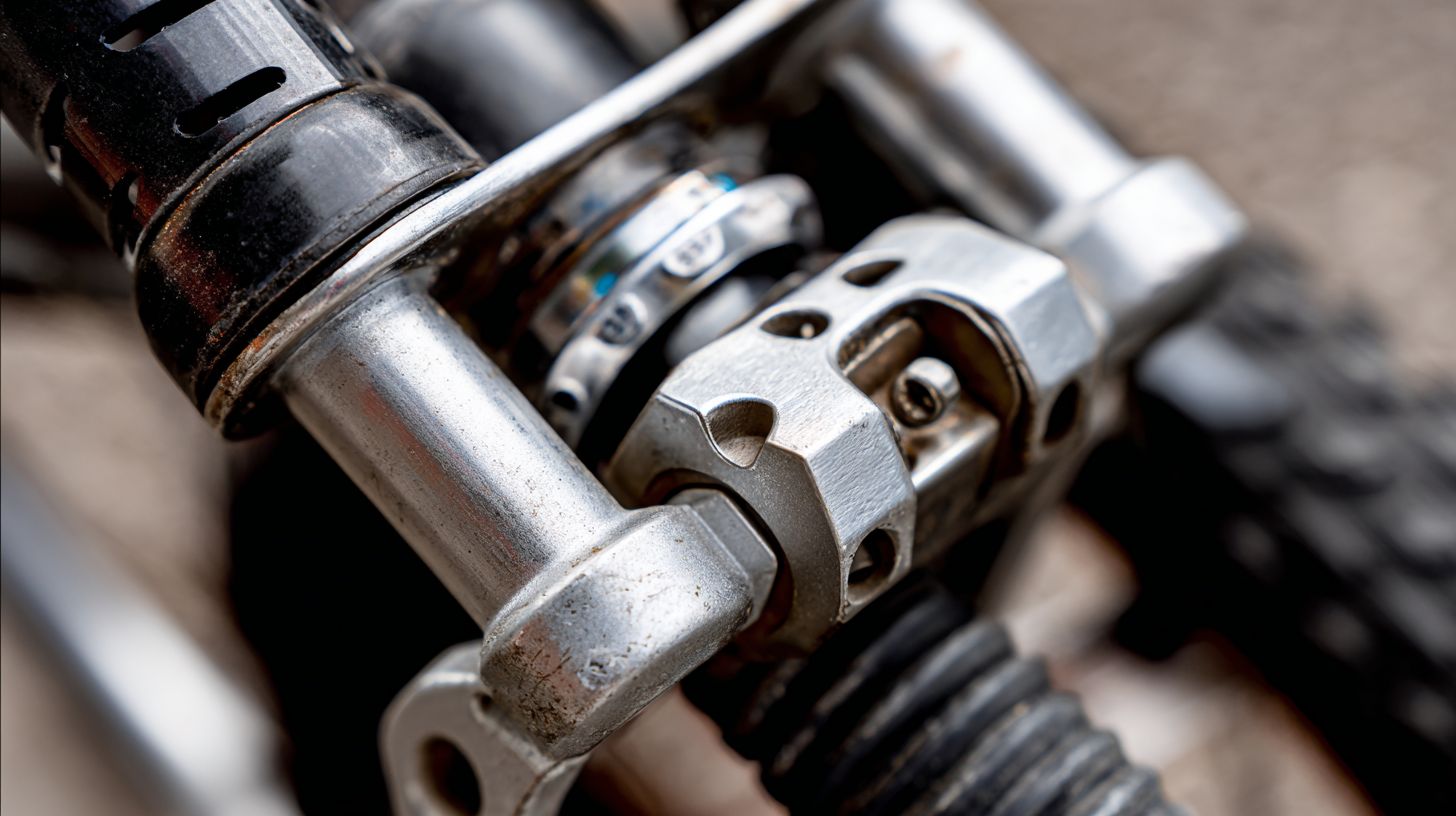In the realm of bicycle performance and safety, the cycle fork plays a pivotal role that is often overlooked by both casual riders and competitive cyclists. According to a report by the International Cycling Union (UCI), a well-designed cycle fork can significantly enhance stability and handling, crucial factors that can affect overall ride quality. In fact, research indicates that a properly aligned cycle fork can improve steering response and increase control, reducing the risk of accidents by up to 30%.
 Furthermore, advancements in materials and engineering have led to the development of lightweight yet durable cycle forks, enhancing the overall efficiency of the bike while ensuring rider safety. As we delve into the intricacies of cycle forks, it's crucial to understand not only their technical specifications but also their impact on rider experience and performance outcomes.
Furthermore, advancements in materials and engineering have led to the development of lightweight yet durable cycle forks, enhancing the overall efficiency of the bike while ensuring rider safety. As we delve into the intricacies of cycle forks, it's crucial to understand not only their technical specifications but also their impact on rider experience and performance outcomes.
When choosing the right cycle fork, several key factors come into play that significantly impact both performance and safety. One of the primary considerations is the fork material. According to a report by the Bicycle Technology Institute, carbon fiber forks are gaining popularity due to their lightweight nature and superior shock absorption qualities. In contrast, aluminum forks tend to be more durable and cost-effective, making them a common choice for casual riders. It’s crucial to match the fork material with your riding style and terrain to achieve the best performance.
Another important factor is the fork geometry, which affects handling and stability. Research from the International Cycling Association highlights that a fork's rake and offset can alter the bike’s steering responsiveness. For instance, a fork with a longer rake provides better stability at high speeds, while a shorter rake enhances maneuverability for technical rides. Additionally, ensuring compatibility with wheel size is essential; forks are designed for specific wheel dimensions, and using the wrong size can lead to handling issues and compromised safety. Considering these factors not only enhances cycling performance but also ensures a safe riding experience.
 The choice of materials used in bicycle forks significantly impacts both performance and durability. Research by the Bicycle Federation highlights that aluminum forks offer an excellent balance of weight and strength, with tensile strength ratings often exceeding 300 MPa. This strength allows for enhanced responsiveness and handling, crucial for competitive cyclists. Conversely, carbon fiber is gaining traction among high-performance riders due to its low weight and high stiffness-to-weight ratio, providing a significant edge in aerodynamics and vibration dampening. Some studies have shown that carbon fiber forks can reduce overall bicycle weight by up to 30%, which can lead to improved climbing and acceleration.
The choice of materials used in bicycle forks significantly impacts both performance and durability. Research by the Bicycle Federation highlights that aluminum forks offer an excellent balance of weight and strength, with tensile strength ratings often exceeding 300 MPa. This strength allows for enhanced responsiveness and handling, crucial for competitive cyclists. Conversely, carbon fiber is gaining traction among high-performance riders due to its low weight and high stiffness-to-weight ratio, providing a significant edge in aerodynamics and vibration dampening. Some studies have shown that carbon fiber forks can reduce overall bicycle weight by up to 30%, which can lead to improved climbing and acceleration.
However, the material choice also directly influences fork longevity and safety. A report from the International Journal of Bicycle Engineering indicates that while carbon fiber forks are lighter, they can be more susceptible to damage from impacts compared to aluminum. A well-designed aluminum fork can endure more stress and is often less expensive to repair or replace. Moreover, data from the Cycling Safety Institute points out that fork failures can lead to severe accidents, underscoring the need for durability in design. Thus, selecting the right fork material is critical not only for performance but also for ensuring the safety of cyclists on the road.
When considering bicycle performance and safety, fork types play a crucial role in determining how a bike handles various terrains and riding styles. Generally, there are two main categories of forks: rigid and suspension.
Rigid forks provide a direct connection to the road, offering improved responsiveness and weight savings, which is ideal for racing or road cycling. Riders who prioritize speed and efficiency often prefer this style, as it enhances their ability to maneuver swiftly through tight corners.
On the other hand, suspension forks are designed to absorb shocks and bumps, greatly benefiting mountain bikers or those riding on uneven surfaces. These forks come in different designs, notably hardtail and full suspension systems.
Hardtail forks offer some cushioning while maintaining the bike's efficiency, making them versatile for cross-country riding. Full suspension forks, however, provide maximum comfort and control on rough trails by allowing the rear wheel to move independently, thus absorbing impacts without compromising the rider's stability.
The choice of fork type not only affects the bike's overall performance but also significantly influences the rider's experience, comfort, and safety on diverse terrains.
Maintaining your bicycle's fork is crucial for ensuring both safety and performance. Regular inspections should be part of every cyclist's routine. Check for any visible damage, such as dents or cracks, which could compromise the fork's integrity. Ensure the fork is clean and free from debris, as dirt and grime can accelerate wear and tear. Pay close attention to the headset and ensure it is properly adjusted; a loose headset can lead to handling issues and put greater stress on the fork during rides.
Lubrication is another key aspect of fork maintenance. Inspect the stanchions for any signs of pitting or scratches, which can affect the fork's performance. Regularly apply a suitable lubricant to the moving parts to reduce friction and enhance functionality. Additionally, if your bike has suspension forks, check the air pressure or oil levels as recommended by the manufacturer to maintain optimal performance. Understanding these maintenance tips can greatly extend the lifespan of your forks and significantly improve your cycling experience.
| Fork Type | Material | Weight (g) | Travel (mm) | Maintenance Frequency (Months) | Common Issues |
|---|---|---|---|---|---|
| Mountain Fork | Aluminum | 1800 | 120 | 6 | Dirt accumulation, Seal wear |
| Road Fork | Carbon Fiber | 850 | 70 | 12 | Cracks, Brake alignment issues |
| Hybrid Fork | Steel | 1300 | 50 | 12 | Rust, Misalignment |
| BMX Fork | Chromoly | 1200 | 20 | 6 | Screw damage, Cracks |
| Fat Bike Fork | Aluminum | 2200 | 150 | 12 | Flex, Alignment issues |
Fork geometry plays a critical role in the handling and stability of bicycles, influencing the rider's experience and safety. A key measurement is the fork angle, which typically ranges between 68° to 75°. A steeper fork angle, such as 75°, allows for quicker steering responses, ideal for racing and agile maneuvering. Conversely, a slacker angle, closer to 68°, promotes enhanced stability at high speeds, making it a favored choice for downhill mountain biking. According to a study conducted by Cycling Weekly, the right fork geometry can improve cornering speed by up to 15%, directly affecting performance on varied terrains.

Another important aspect is the fork offset, which impacts trail—a crucial parameter affecting handling. An optimal trail measurement helps maintain stability while offering responsive steering. Research from the International Journal of Bicycle Design indicates that a trail measurement of 60mm tends to provide the best balance for most cyclists, blending responsive handling with enough stability for descending. Additionally, variations in fork length can alter the wheelbase, further affecting the bike's feel and steering dynamics. These factors show that understanding fork geometry is not just about preference; it directly influences overall safety and performance on the road or trail.






